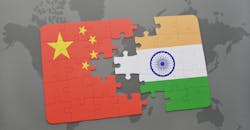Will India’s Industrial Ambition Thwart China?
The September G20 Summit meeting in New Delhi put India’s prime minister, Narendra Modi, front and center among leaders of the world’s top 20 economies. Despite China’s President Xi Jinping’s absence at G20, trade between India and China has been strong, as it reached a record $135.98 billion in 2022.
But things are going to change between these two neighboring countries for strategic and economic reasons.
On one level, India and China share a common interest in dethroning the U.S. dollar. They want to create a common currency for trade and investment among BRICS members, reducing their vulnerability to dollar exchange-rate fluctuations.
However, on a different level, the leaders of these two countries have different goals.
Xi wants to lead a reform of the global governance system, putting China at the center of the new world order. Modi, on the other hand, wants to transform India into one of the world’s top three economies within five years.
To stimulate economic growth in India, Modi has launched various initiatives to encourage foreign direct investment (FDI), create jobs in the manufacturing sector and stimulate innovation. The Indian government is also deterring Chinese firms from entering or expanding in India.
First, India has been attracting FDI to further develop several sectors, including services, computer software and hardware, telecommunications, automobiles and pharmaceuticals. For example, in 2019, the Indian government relaxed FDI policy by allowing 100% FDI in contract manufacturing, single-brand retail trading and digital media. By 2022, FDI flows into India rose 10%, from $44.7 billion in 2021 to $49.3 billion in 2022—making India the third-largest recipient of FDI in the world that year.
This relaxed FDI policy has attracted Western firms such as Amazon, Apple, Samsung, IKEA and Pfizer to invest in India. In June, Apple announced its plan to shift 18% of its global iPhone production from China to India. In September, semiconductor manufacturer Micron Technology announced plans to build several assembly and packaging units in India.
While India attempts to attract FDI from Western countries, it is trying to discourage FDI from China at the same time. This strategic move intended to reduce its dependence on China is timed well with the U.S. and European Union de-risking from China.
Specifically, the Indian government amended its FDI Policy in April 2020, requiring foreign firms operating in India to obtain prior government approval for FDI received from countries that “share a land border” with India. Although this updated rule could affect FDI from various neighboring countries such as Bangladesh, Pakistan and Bhutan, the intended target is likely China.
Since this updated FDI policy took effect in 2020, India has approved less than a quarter of the 435 applications for FDI from China. For example, after two years of failed attempts to obtain $1 billion FDI approvals from India, China’s largest SUV manufacturer, Great Wall Motor Company Ltd., announced plans to exit India in July 2022.
Second, to build up its domestic manufacturing sector, India has enticed Taiwan-based Foxconn, the world's largest contract manufacturer of electronics, to invest $600 million in the state of Karnataka to make casting components for Apple’s iPhone and other chip-making equipment.
To create and protect jobs for Indians as part of Modi’s “Made in India” campaign launched in 2014, India tries to discourage Chinese factories in India from staying by creating bureaucratic friction—finding fault with businesses that are out of favor. For instance, it is well known that it is virtually impossible to comply with extremely complex Indian tax rules. In August, the Indian government accused the Indian arm of Chinese car manufacturer BYD and the Indian unit of Chinese mobile phone manufacturer BBK Electronics (which owns Oppo and Vivo) for evading customs duty for parts imported from abroad.
The intent here is to curtail Chinese firms’ expansion so Indian firms can fill the gap.
Third, to support its export-oriented growth model, India used tariffs to discourage imports. In 2018, in an effort to reverse the demise of Indian mobile phone assembly at the hands of Chinese rivals, the government imposed a 20% levy on imported devices. In 2020, it tripled tariffs to 60% on toy imports, most of which come from China. By 2023, the import tariffs increased to 70%, reducing India’s toy imports by 75% since 2019.
In addition to reducing imports, India introduced the “production-linked incentives” (PLI) scheme in 2020 to provide companies with incentives for sale of products manufactured in India. This scheme has expanded into a $24 billion program focusing on 13 areas, including auto components, automobile, electronics systems, telecom equipment, etc.
The PLI scheme can create jobs and income for Indian workers, boost economic growth, promote exports, reduce the trade deficit, improve the quality and standards of Indian products, and foster innovation and technology transfer, as well as encourage research and development (R&D) activities.
As India deploys all these tools to boost domestic production by curbing Chinese operations in India, it aims to increase manufacturing’s share of GDP to 25% from the current 17.7% by 2025.
Will this happen by 2025? I do not know, but as I learned from the movie “The Best Exotic Marigold Hotel,” “Everything will be all right in the end. If it’s not all right, it is not yet the end.”
Christopher Tang is a distinguished professor at the UCLA Anderson School of Management.
